Chris Baty's Blog, page 94
October 18, 2018
Road Trip to NaNo: A Year of Moving Forward

Last year, Puerto Rico was struck by a devastating hurricane, and we shared a Road Trip to NaNo post from Amanda Rosa, our Municipal Liaison in the USA :: Puerto Rico region. Today, she returns to share how writing has helped her region and community has persevered in the year since:
Perseverance.That’s the one word I can use to describe our region of Puerto Rico. Last year was a bad one for us; our island got hit with hurricane Maria a few months before NaNo. For a moment the attention of the whole world was on us as we faced one of our biggest tragedies, one we are still facing. I won’t deny that our activity last year in the event was at an all-time low. Some members had decided to move away from the island, others didn’t have electricity or access to internet or simply other priorities took precedence to NaNo, and that is understandable.
However, that doesn’t mean we stop writing. Our member maitetxu, who didn’t have electricity, started to edit a novel and several short stories she had already started during a previous NaNo. Now, she is a published author! Those same stories got published in the book Ojos Llenos de Arena by Maite Ramos Ortiz. Another participant took the time to start publishing her novel, chapter by chapter, on a popular website. Other Wrimos decided to participate in the various Camp NaNos to make up for the missed event in November.
There is no doubt that it was a hard time for our region—but we kept going. We have persevered. This whole experience has taught me that there are no excuses not to write. Even if you are going through a hard time, writing can be the escape that you need. By building a whole new world with your tears, smiles, laughter, fears, worries, your story can make your life better! That story can even inspire others, from the people close to you to people across the world.
Take this as a challenge to feel inspired and to persevere despite adversity. When the world is telling you no to your dreams, you scream yes! You can make time to write at least 10 minutes every day; or, maybe, you have more time and can write for an hour or more. Every word counts. Not feeling inspired to write? Take last year’s NaNo project and rewrite it or take the time to finally edit it. Be a rebel!
So let’s get that countdown to November started and think of all the people that have persevered. They kept trying, even if it was little by little, until they succeeded. And so can you—so finish that novel you always wanted to write!

Amanda Rosa is a Municipal Liaison for the Puerto Rico region and participant of Nanowrimo since 2010. She enjoys writing fantasy, romance and Contemporary NA. She graduated from the University of Puerto Rico with a geography major. She is currently working as a Sales Manager and trying to open up an Etsy store. You can follow her on Twitter @mandylola.
Top image licensed under Creative Commons from Diablo_blanco on Flickr, with added text.
October 17, 2018
The 3 Most Important Writing Habits of Bestselling Authors
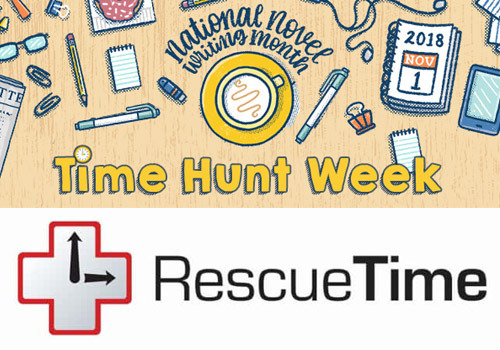
Every year, we’re lucky to have great sponsors for our nonprofit events. This week, we’re focusing on helping you find the time in your busy schedule to sit down and write a novel next month. RescueTime, a NaNoWriMo 2018 sponsor, is here today with some helpful time management tips:
Like any major creative project, writing a novel in just 30 days takes serious dedication. But even more than that, it takes mastery of your daily schedule, habits, routines, and focus.
As John Grisham, author of more than 35 New York Times-bestselling novels explains:
“Routine is what it’s all about. You’ve got to get into a [writing] routine that is second nature.”
Our lives are driven by habit and routine. In fact, most studies agree that close to 40% of our daily actions are driven by unconscious habits. In order to write consistently, you need to build a routine that gets you writing and gets rid of anything getting in the way.
Here are 3 of the most important writing habits and routines of best-selling authors and how RescueTime—the award-winning time management and productivity app—can help you stick to them.
We’re thrilled to be sponsoring NaNoWriMo 2018! Sign up for RescueTime today and get all our Premium features for free through NaNoWriMo. Find out more here.
1. Find the right time to write each day (and commit to it)Let’s start with a bit of basic math. To hit your NaNoWriMo goal, you need to write 11,700 words a week. That’s no small feat for any writer (even the pros). But as everyone from Grisham to Haruki Murakami to Stephen King will tell you, writing novels is all about finding your optimal writing hours and sticking to them.
When Grisham first started writing novels, he followed a specific routine of getting up at 5 am, getting to his office, and writing his first words by 5:30 am. While Haruki Murakami follows a strict schedule of waking at 4 am and writing for 5–6 hours before going for a swim.
This isn’t to say you have to wake up at 4 or 5 am to write. But rather that you need to find the time that works best for you and that you can commit to every single day. RescueTime automatically tracks the time you spend on your digital devices and helps you plan out the exact time you need each day to hit your writing goals.
As Shanna Peeples, National Teacher of the Year and author of Think like Socrates, told us:
“RescueTime is like the Weight Watchers of time—helping me become aware of how I’m using my minutes and manage them better.”
2. Block distractions to stay motivated throughout your writing sessionsBack when I was in school, a professor told me that success as a writer comes down to BIC: Butt in Chair. When you’re halfway through NaNoWriMo and your motivation is waning, it’s easy to find excuses to give up. Instead, you need to block the distractions that try to take you away from your writing.
Willpower and commitment are powerful tools, not only for keeping you on track to hit your goals, but also to help you fight the deadly inner critic and get over the myth of the muse—the idea that you can only write when you “feel inspired.” For, as writer Neil Gaiman explains:
“If you’re only going to write when you’re inspired, you may be a fairly decent poet, but you will never be a novelist—because you’re going to have to make your word count today, and those words aren’t going to wait for you, whether you’re inspired or not.”
RescueTime helps you stay motivated and committed by automatically blocking distracting websites and social media on your computer when you’re trying to write, while also giving you real-time nudges throughout the day to help you stay on track.
3. Set smaller, realistic goals and track your progress towards finishing your novelWriting a 50,000 word novel in a month is hard, but doable. Yet unless you can dedicate enormous blocks of time to it you’re going to have to squeeze writing time into small chunks of the day. And while those chunks add up, you need to track your progress if you want to stay committed and hit your goal.
As author Jocelyn K. Glei says:
“Most of us make advances small and large every single day, but we fail to notice them because we lack a method for acknowledging our progress. This is a huge loss.”
RescueTime sends you weekly reports, detailing your actual writing time and progress and giving you advice on how to adjust your schedule to find time to write.
Every writer struggles with finding the time to write. Now, with RescueTime and NaNoWriMo, you have the tools and support you need to build a solid writing routine, fight distractions, and stay focused as you bring your characters and story to life in just 30 days.
Robby Macdonell is CEO of RescueTime—a time management and productivity tool used by hundreds of thousands of people to block distractions, understand their productivity, and find time to work on their most important tasks. Sign up for RescueTime today and get our Premium features for free through the month of November (with a deep discount on continuing subscriptions).
October 16, 2018
30 Covers, 30 Days 2018: An Introduction
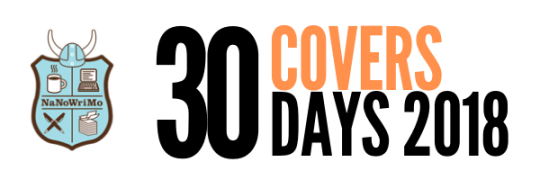 Now recruiting all Wrimos!
Now recruiting all Wrimos!Yes, it’s me again—your friendly neighborhood intern, Nick—here to announce that this year’s edition of 30 Covers, 30 Days is open!
Fall is upon us, prep season is in full swing, and November is fast approaching, which means it’s time for one of our favorite parts of NaNoWriMo!
What is 30 Covers, 30 Days?Thirty very lucky Wrimos will be chosen to have a cover for their 2018 NaNo novel, designed by one of the many talented artists recruited by our wonderful coordinator, Debbie Millman.
Debbie is a writer, educator, artist, brand consultant and host of the radio show Design Matters—not to mention President of Sterling Brands for the last twenty years and President Emeritus of the American Institute of Graphic Arts. So don’t worry, your novel is in very capable hands.
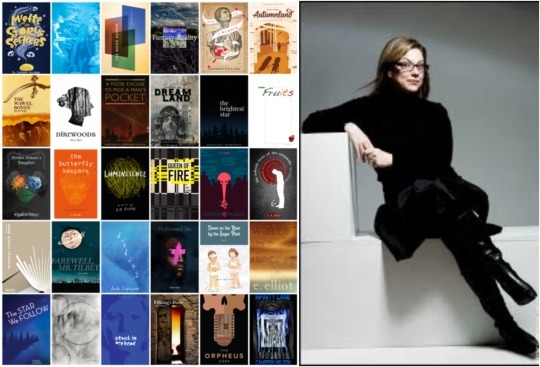
We’ll be posting a new cover every day of November, both on this blog and on our forums. If you’d like to see what some of our previous covers were like, you can check them out here.
That sounds super cool! How do I sign up?Submitting your novel is easier than ever. All you have to do is complete this form.
A few things to know before you submit your novel:
Your form can’t be edited once you submit it, so please read the entire form carefully. There are ways to withdraw and resubmit, however — and you can find those details in the original post on the 30 Covers, 30 Days Intro thread. There’s more information on the whole process in that thread, too.You don’t have to use your real name. We celebrate and encourage pen names!If your novel is selected, we’ll get in touch with you, and we can all jump up and down and hug and cry together (happy tears).If you have any questions about 30 Covers, 30 Days, feel free to post in the forum, or send me a NaNoMail.
In the meantime, check out the NaNo Artisans forum to have a cover designed by a fellow Wrimo, or design one yourself.
The submission form is open until November 15.Now go forth and make your novel!
-Nick Fierro, NaNo Intern
October 15, 2018
Do You Rule Your Habits or Do They Rule You?

We’re deep into NaNo Prep Season , and we’ve dubbed this week “Time Hunt Week”! We’ll be sharing resources throughout the week to help you find the time to establish writing routines in November. Today, NaNoWriMo Executive Director Grant Faulkner shares an excerpt on forming habits from his book, Pep Talks for Writers :
“I don’t like writing. I like having written,” Dorothy Parker famously said. Writing can be daunting, frustrating, and even frightening—yet then, somehow, magically fulfilling. That’s why having a writing routine can be such a powerful writing aid. If there’s a single defining trait among most successful writers—and especially writers who reach 50K words in November—it’s that they show up to write regularly, no matter if they write at midnight or dawn, or at a desk or in a car.
“A goal without a plan is a dream,” said Antoine Saint Exupery. And a routine is a plan. A plan of dedication. A routine helps obliterate any obstacle hindering you from writing, whether it’s a psychological block or a tantalizing party invitation.
But it’s even more than that. When you write during a certain time each day, and in an environment designated solely for rumination, you experience creative benefits. The regularity of time and place serves as an invitation for your mind to walk through the doorways of your imagination and fully concentrate on your story. Routines help to trigger cognitive cues that are associated with your story, cloaking you in the ideas, images, and feelings that are swirling in your subconscious. If you anoint a specific time and place for writing, it’s easier to transcend the intrusive fretfulness of life and rise above its cacophony. Regularity and repetition are like guides who lead you deeper into the realm of your imagination.
In fact, another name for “muse” might be “routine.” When you work regularly, inspiration strikes regularly. That’s because you’re carried forward by the reassuring momentum of your progress, absorbed in a type of mesmerism.
“A routine provides a safe and stable place for your imagination to roam, dance, do somersaults, and jump off of cliffs.“Stephen King is perhaps the perfect case study of such a writer. He compares his writing room to his bedroom, a private place of dreams. “Your schedule—in at about the same time every day, out when your thousand words are on paper or disk—exists in order to habituate yourself, to make yourself ready to dream just as you make yourself ready to sleep by going to bed at roughly the same time each night and following the same ritual as you go.”
But, wait, aren’t artists supposed to be freewheeling, undisciplined creatures more inclined to follow the fancies of their imagination than the rigid regularities of a schedule? Doesn’t routine subvert and suffocate creativity? Quite the opposite. A routine provides a safe and stable place for your imagination to roam, dance, do somersaults, and jump off of cliffs. Think of your routine like a giant bouncy house.
Also, routines don’t have to be overly routinized. I have a tradition of buying a new hat for each new novel I write—a hat that fits the theme if possible—just to change my writing energy a bit. When I put on the hat, I get into the character of the novel and signal to my brain that I’m ready to write. For one macabre tale, I wore a “coffin hat” (a short version of a top hat). For another one, I wore a derby. This year’s NaNoWriMo novel is calling for brightly-colored visor.
Make your routine like a hat you put on each day.

Grant Faulkner is the executive director of NaNoWriMo. He received his B.A. from Grinnell College in English and his M.A. in Creative Writing from San Francisco State University. He has published stories and essays in The New York Times, Poets & Writers, Writer’s Digest, The Southwest Review, The Rumpus, Gargoyle, and The Berkeley Fiction Review, among dozens of others. He’s also the founder and editor of the lit journal 100 Word Story, and has published a collection of 100-word stories, Fissures.
Top image licensed under Creative Commons from Stuart Rankin on Flickr.
October 12, 2018
Road Trip to NaNo: Writing in the Heart of the Blue Ridge Mountains
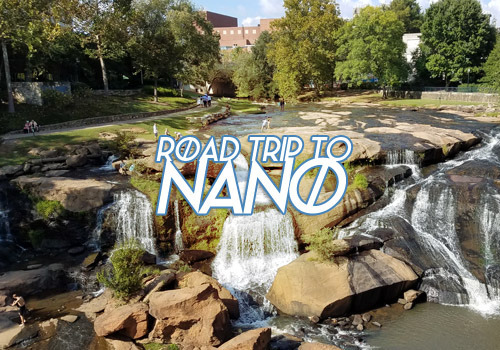
NaNoWriMo is a worldwide event, and we’re taking a Road Trip to NaNo to hear about the stories being written every year in our hundreds of participating regions. Today, Linda Bennett, Municipal Liaison for the USA :: South Carolina :: Greenville region, shares how her region has shaped her writing:
My region, Greenville, is a county tucked up near the Blue Ridge Mountains, in the northwest corner of South Carolina. The county seat is also named Greenville; it’s a busy, lively little city situated just north of the county’s center. But it didn’t used to be so busy or lively.
Greenville’s history is one of textiles. There were cotton mills studded all around the city, creating little neighborhoods or mill towns with their own stores, clusters of homes, and even their own baseball teams. The remnants of that era can still be seen in the names of the neighborhoods and the tall water towers that marked each mill.
But the textile industry died in Greenville and the city almost died with it. The city was depressed, the downtown full of closed shops and restaurants.
Then a mayor named Max Heller had a vision. He saw the downtown as a European city, with museums and shops and restaurants all within walking distance. So he did what mayors do to raise money and brought that vision to life. He took two traffic lanes of Main Street to build wide sidewalks and parking for cars. He planted trees along the sidewalks. He built a public art museum and a public library next to it, then a theater on the other side.

It worked. People came downtown. Shops and restaurants opened up. New industry moved in. Old buildings were renovated. New buildings were built. Slowly, the city came back to life.
Each successive mayor has carried on that vision. One even demolished a bridge to expose a thirty-foot waterfall, then built a park around it. He replaced the traffic bridge with a unique suspension pedestrian bridge, making the park a great place for families to gather. There’s even a baseball stadium downtown now, right on Main Street. The one library is now the hub of our marvelous county library system and three more museums have been added to what the mayor called “Heritage Green”.
When I think of Greenville’s past and present, I think of that mayor’s vision. He had an idea of what Greenville could become. He pursued his vision. It had a beginning, but he knew he might not see the end of it. Because rebuilding a city or a county takes time.
Do you have a vision for your novel? Do you have a beginning? Do you know where it’s supposed to end up? I’m a pantser, not a planner, so planning out my novel ahead of time isn’t something I’m used to doing. I don’t prepare detailed outlines or character sketches.
But I do have a vision. I know how my story is supposed to go, where it begins and where it ends. I know who my main character is, what they look like. I see my opening and ending scenes very clearly. The dialog. The surroundings. The action. These things I can jot down ahead of time.
I also keep a pad of paper and writing implement by my bed. The best time for inspiration is when you’re just about to go to sleep. The problem is, I don’t remember what I’d thought of when I wake up! So, make it a habit to write down any inspiration you might have. It’ll add to your vision for your novel or save you from writer’s block down the road.
Having a vision for my novel, seeing it in my mind’s eye, makes me want November to arrive! How about you?

Linda Bennett (Co-ML of South Carolina::Greenville) is a domestic engineer and crazy cat lady wannabe. She has the crazy part down already. She holds two degrees, a B.Sci in Graphic design and an M.Ed in English Education. In addition to her two cats and granddog, she lives with her husband of 30+ years and two of her three grown children. She’s been at this NaNo thing since 2005 and the ML gig since 2008.
October 11, 2018
What kind of NaNoWriMo writer are you? We’ve put together this...
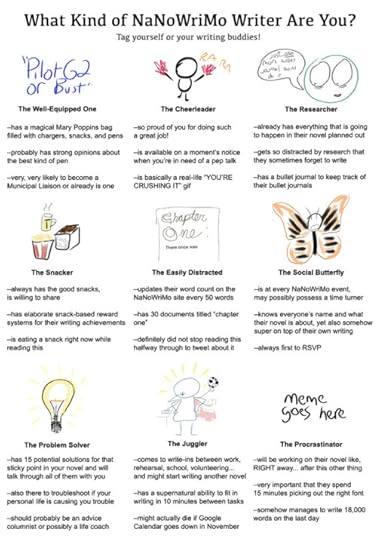
What kind of NaNoWriMo writer are you?
We’ve put together this handy-dandy chart to help you figure out what kind of writer you (and your friends) are. Tag yourself or your writing buddies!
[text description below]
The Well-Equipped One
has a magical Mary Poppins bag filled with chargers, snacks, and pensprobably has strong opinions about the best kind of pen
very, very likely to become a Municipal Liaison or already is one
The Cheerleader
so proud of you for doing such a great job!is available on a moment’s notice when you’re in need of a pep talk
is basically a real-life “YOU’RE CRUSHING IT” gif
The Researcher
already has everything that is going to happen in their novel planned outgets so distracted by research that they sometimes forget to write
has a bullet journal to keep track of their bullet journals
The Snacker
always has the good snacks, is willing to sharehas elaborate snack-based reward systems for their writing achievements
is eating a snack right now while reading this
The Easily Distracted
updates their word count on the NaNoWriMo site every 50 wordshas 30 documents titled “chapter one”
definitely did not stop reading this halfway through to tweet about it
The Social Butterfly
is at every NaNoWriMo event, may possibly possess a time turnerknows everyone’s name and what their novel is about, yet also somehow super on top of their own writing
always first to RSVP
The Problem Solver
has 15 potential solutions for that sticky point in your novel and will talk through all of them with youalso there to troubleshoot if your personal life is causing you trouble
should probably be an advice columnist or possibly a life coach
The Juggler
comes to write-ins between work,rehearsal, school, volunteering… and might start writing another novelhas a supernatural ability to fit in writing in 10 minutes between tasks
might actually die if Google Calendar goes down in November
The Procrastinator
will be working on their novel like, RIGHT away… after this other thingvery important that they spend 15 minutes picking out the right font
somehow manages to write 18,000 words on the last day
October 10, 2018
Just Write! With The Great Courses Plus

Every year, we’re lucky to have great sponsors for our nonprofit events. While it may seem like your list of questions about writing, editing, and publishing gets longer every day, The Great Courses Plus, a NaNoWriMo 2018 sponsor, is here today with some courses to help you write your way through November:
50,000 words.
FIFTY.
THOUSAND.
WORDS.
If you’ve committed to NaNoWriMo, you’ve signed up for one month to write 50,000 words in 30 days.
Don’t panic! Deep breath. You can do it. And The Great Courses Plus is here to help.
The countdown to November has started, and now is the time to prepare. With The Great Courses Plus, you can get motivated by looking at what first sparked your love of writing as you gain illuminating insights about beloved books and authors. Dig deep into visionary science fiction, heart-stopping mystery and suspense, or the beautiful and terrifying worlds of utopian and dystopian literature. No matter what genre you’re working in, discovering how your favorite writers write and breaking down why your favorite works work is both inspiring and edifying.
You can also step back and examine the technique of great writing at a higher level, from the nuts and bolts of grammar and vocabulary, to crafting the perfect sentence, to putting it all together and getting your works published. You’ll gain expert tips, tricks, and techniques that help you take your writing to the next level, move past writer’s block and other common obstacles, and apply a critical eye to your final product.
Led by renowned authors, writing professors at top universities, publishing industry experts, and more, this carefully-curated selection of Great Courses gives you a myriad of resources at your fingertips that provide help, inspiration, and encouragement for every step of your process.
The Great Courses Plus provides more than just storytelling help. Need to know the historical chain of events to make your story authentic? Looking for the exact chemical compound that will make your spacecraft fly? Want to throw in a line of Spanish or French from a native speaker? We’ve got more than 10,000 videos across dozens of subjects to help you access all the information you need for whatever you’re writing about.
As a NaNoWriMo participant, you’ll have access to stream all these courses for a month for FREE, PLUS you’ll get 50% off the first two months of your membership—just in time to get published! Be sure to use the code NANO in the checkout to receive this offer to The Great Courses Plus.
Take another deep breath. Immerse yourself in captivating, advantageous, and entertaining resources that are guaranteed to make this journey easier, so that when November 1 rolls around, 50,000 words will feel just right.
October 9, 2018
How to Grow a Writing Community

As we prepare for November, we’re asking members of the NaNo community for their best advice on writing and making the most of the month. Today, writer K.A. Magrowski shares what makes having a writing community to grow and cheer with so great:
Despite the what the doomsayers may tell you about the changing face of publication, writing and storytelling is more important than ever. Humans have a need to tell stories, from the time of our ancestors sitting around a fire over a fresh kill, to the Greek poets, to today, where our screens have replaced the roaring fires and more people have access to books than ever before. Happily as well, more people are writing books, short stories, poems, scripts, and plays than ever before. And while writing is often thought of as a solitary endeavor, it doesn’t need to be. A local or virtual writing community is a writer’s beacon in the storm.
Growing a writing community isn’t easy. You start slow and small: you put up an ad on a library wall, or in a local bookstore if you’re lucky enough to have one. Then, a few writers gather in a dusty library room or a small corner of a bookstore. Maybe you trade manuscripts, or read passages aloud; you may exchange personal stories of rejections and, with luck, an acceptance or two. Newbies and pros alike flock to your group, looking for someone who understands.
They’re asking the same questions you are. Why do you need to write stories? Why give yourself homework for the rest of your life? Why spend your time hunched over a computer, coffee stains on your mousepad, typing furiously in the middle of the night, or in the morning before anyone is awake? Why write for the whole weekend when everyone else is binge watching something on Netflix?
It is with the help of your writing community that you can find the answers.
Small intimate gatherings may swell to large groups, or they may remain small. Regardless of size, a sense of community and family will develop, and no matter what the outside world throws at you, know that your group has your back.
As a long-time member and current president of the South Jersey Writers’ Group (SJWG), I have seen many new members come through our doors. They’re nervous, eyeing us up like prey wandering into a room full of predators; I have to laugh a little, because, after all, most of us have heard the horror stories of writers’ groups full of bloated egos and relentless back-stabbing.
But that’s not representative of the writers I know. Most are more than happy to share their knowledge, to cheer someone on, to commiserate over rejections and a hair-pulling revision process. In our group, we all contribute by sharing our experiences in writing, or publishing, or a particular field of expertise. Each is generous with their knowledge and time and ready to answer questions because that’s what’s we do.
And that is what building a writing community means and what it looks like: we support and build each other up. It’s not about competition, not about tearing others down, not about the stabbing of the backs. We are there for each other. Sometimes with knowledge, sometimes with a hug, sometimes with a friendly, but honest critique. You don’t need to be a famous published writer to build your community. You just need the passion to write and a few other writers who want to share a journey with you.

K.A. Magrowski is a self-styled Gamer / Geek / Triathlete / Bibliophile / Cat Lady who hails from the haunted wilds of South Jersey, home of the Jersey Devil. Fueled by coffee and wine, she writes speculative fiction for children and adults. Her short work has appeared in Dreams of Decadence magazine, and the anthologies Tall Tales and Short Stories from South Jersey, Reading Glasses, and We Walk Invisible, as well as online sites.
Photo by Štefan Štefančík on Unsplash.
October 8, 2018
Nobody Told Me That Writing and Parenting Are (Basically) The Same

November is fast approaching, and in preparation we’ve asked some participants to offer their best writing advice. Today, author Debora Hellinga shares her perspective on how to “raise” a story like a child:
There are a whole lot of theories and opinions concerning writing, authors, and books out there in the big wide mean world. How a room should be depicted or how it should have been depicted; how to describe or rather not describe characters; how to give unique voices to your characters, but (then again) don’t have too many characters because it’s hard to keep all these (imaginary?) people separated. When someone tells me that, I always wonder if they live in a world with only five people.
There are a lot of ‘How To’ lists, books, articles, columns, and blogs out there in the ever bigger, wider, and meaner internet when it comes to writing. And, let’s be honest: it’s a mess. One page says you should outline your book down to every detail, then another article says you should just let your characters be free and explore the world on their own. One person says you should know your characters’ entire family history as far as five generations into the past, while another says it’s best to keep them ambiguous.
Honestly, writing feels a lot like parenting: everyone has their own techniques and methods and opinions, and everyone thinks they’re right.Then again — like children — every book is different. And let me tell you: those people are intriguing. How they manoeuvre through life and how they deal with events, both the ones they like and the ones that are far outside of their comfort zone and they don’t want to be confronted with.
Every single individual has their own mind, their own hopes and fears, own past and present and future, own struggle with pain and own approach towards healing. They have inside jokes with friends and family which you and I would never understand; they have people who they admire and people who they deeply dislike. There are things they wish for, clothes they love, films they identify with, and there’s that one dish that they really like. In short, people are details.
This is what no one told me when I started writing; I had no idea that my characters would venture out into their world and have their little journey of life. When I first imagined them, I didn’t expect them to develop such unique voices on their own. What’s more, it’s endlessly frustrating to have to explain to others that the characters you created are having their own conversations and you aren’t even invited.
In that sense, writing really is like parenting. Everyone has their opinions and methods concerning raising their child. Everyone is pretty vocal about their techniques and how amazing they are and how wonderful their child is. But nobody really talks about what it’s like when your child has been crying for six hours straight, or the shapes and colours of poopy diapers, or the intense rage a one-year-old can explode upon you.
Nobody talks about the discussions you can have with your characters; how you can tell them for the 1000th time that all of you are going left, and that one stubborn character still does a U-turn. Nobody tells you how characters can keep you awake at night to tell you about that one summer night they thought they discovered the meaning of life only to be stabbed in the back by that so-called ‘True Love’ the next morning.
So, please allow me to tell you the raw truth: just like children, characters are exhausting. Keep a notebook near so you can write down what they have to tell you, so they’ll leave you alone and you can continue with your daily life. Plus, this way you’ll have all your ideas written out and in front of you whenever you might need them! And your characters are no longer chattering in your head, which is also nice if you want to sleep.

Debora Hellinga (24) currently lives in Groningen, the Netherlands, where she studies English Literature & Culture. Her first book ‘Red Dawn Rising’ is out now and is available via Amazon.co.uk, Waterstones, Gardners, and Bol.com
October 5, 2018
In Case of Inspiration Emergency: Revisit Your Childhood Favorites

Whether you’re a planner or not, there’s one thing every writer will need as they prepare for NaNoWriMo : inspiration. We’ve challenged some of the NaNo staff to inspire you by sharing what’s inspired them… and challenging you to prepare a specific jumpstart for that inevitable idea drought:
The Inspirer: Katharine Gripp, NaNoWriMo Communications Manager
The Inspiration Sources:
The Phantom of the Opera by Andrew Lloyd WebberFire and Hemlock by Diana Wynne Jones
The Jumpstart: Revisit the things that fired your imagination and made you excited to delve into wild creativity when you were younger! You may find that you effortlessly capture the same sense of heady possibility that you had when you first read, heard, or watched it. You may find that it doesn’t live up to your memories of it, or that you resonate with different characters or themes now that you’re in a different place in your life. If the former, unashamedly ride that wave of excitement to write about the things you find glamorous and glorious! If the latter, explore the differences between your new and old experiences of the same material, and write about what you would like to see in that story now.
Why This Will Inspire You: This prompt came to me because I recently saw the touring Broadway stage version of Phantom of the Opera for the very first time. The movie version came out when I was about 14 and I LOVED it. The period costumes! The overly dramatic gothic decor! Ballet and swordfights! It was all very much the aesthetic I wanted to have.
When it came to my attention that my partner had never seen any version of Phantom, and that the musical was touring in our city, I decided we had to go. As soon as the lights dimmed in that decadent theater with the cobweb-covered chandelier above, and the melody of the prologue started to play, my heart started to race and my eyes began to sparkle. Even though it had been years since I’d listened to the soundtrack, I still knew just about every single word of every song. I was excited to share all of my favorite parts with my partner, who was seeing it through fresh eyes. A little girl of about 8 sat next to us and gasped every time the Phantom disappeared in a flash of fire and smoke.
Watching one of my favorite stories in a different medium after years of not engaging with it also made me look at it with a different perspective. While I always knew that none of the relationships between the characters were particularly healthy (no matter how much I daydreamed about a dashing musical genius giving me the full run of his baroque playground in the catacombs beneath Paris), it made me realize that the play could easily be titled Christine Daae Is Just Trying to Live Her Best Life But She’s Surrounded by Men Who Make Terrible Decisions For Her (although it’s not quite as catchy, I know). I found myself wondering how the story would be different if the women in this play had more agency. What if Madame Giry got to run the Opera House? What if Christine decided she wanted to run off to America or Australia instead?
Sometimes, it’s a feeling rather than a story that captures you. One of the reasons I loved Phantom so much when I was younger was the feeling that there could be another world, with a different set of rules, just beneath the surface of the everyday world that we see. The theater itself is a different world, and the world of backstage has its own rules and mysteries that the audience never sees. Shortly after my obsession with Phantom began to wane, I discovered a book that gave me that same feeling of different worlds just beneath the skin of everyday normalcy: Fire and Hemlock, by Diana Wynne Jones.
The first time I read it, I felt a tension between the story on the page and the rest of the untold story that I wanted to know. That tension has only grown stronger with each rereading. This book is a modern fairy tale loosely based on two old Scottish ballads: Tam Lin, in which a young woman must rescue her shape-changing lover from the clutches of the Faery Queen, and Thomas the Rhymer, in which a bard gets taken away (again by the Faery Queen) and is cursed to tell the truth.
There are lots of things that keep me coming back to this book: some good, some not so good, and some confusing. Jones has been a long-time favorite author for me, in part because of her ability to put stingingly exact metaphors to universal experiences (my favorite in Fire and Hemlock is when the main character feels “bleached with shame”—I’ve definitely been there, and I can feel the echoes of that exact feeling in my own body when reading that passage). But I always put this book down feeling like I missed some important detail, wanting to know more.
Reading books that draw me into their world and yet still leave me with a niggling doubt, discomfort, or curiosity help me figure out what I value in my own writing. Is it most important to you that the readers know the rules of your world, or that they’re figuring things out right along with the main character? Do you intentionally want to make your reader feel uncomfortable or questioning? Do you want to resolve their questions, or leave them open-ended… perhaps to inspire someone else down the road?

Katharine loves being the Communications Manager for NaNoWriMo, where she gets to indulge in her life-long addiction to Young Adult fantasy novels. When not writing, Katharine spends her time dancing, working on cosplays that she never finishes, playing folk-punk music with her band, and spending as much time in the sunshine as she can.
Top photo of lightbulb by Júnior Ferreira on Unsplash. Other media cover images belong to the owners.
Chris Baty's Blog
- Chris Baty's profile
- 63 followers



